

 |
 |
My cloud battle with the 2018 Autumn to early Winter season has been a tough experience. This really has been a strange period, both in terms of cloud cover and weather for astronomical photography. First of all this time of year is normally a dynamic period with an abundance of storms which often provide numerous photo opportunities due to unstable air over the ocean generating moonlit convection and coastal thunderstorms. However this hasn't been the case, to date the vast majority of storm systems have been devoid of CAPE meaning all we have been getting is rain followed by cloudy skies and no weather action at all of a convective nature. In addition to this we are in the depths of solar minimum so there has been a massive decrease in coverage of aurora displays and those which have formed have been weak G1 events which produced little in the way of beams and more often than not they have been clouded out anyway. Cloud cover has been the greatest concern of all, on average we have been getting one good clear night a week which has been unacceptable, I honestly have never seen a period of weather like it since I began observing in the late nineties. That being said I'm an opportunist and tenacious in nature when it comes to my passions in life so I never give up and will take advantage of a decent clear night which presents itself, when this happens I will make the most of it and make the night count, my goal is to never come home empty handed and if possible obtain at least one 'digital trophy' from a shoot, it's these sessions which I have detailed below.
September 21st
The 21st looked clear so John Fagan and I planned a photo shoot along the Co. Antrim coast. The night was forecast to be clear and cold with scattered showers and a waxing gibbous moon in the sky. We are big fans of moonlight, we consider the moon to be our best friend, if you are not shooting auroras, meteor showers or comets then for night sky photography it's often ideal to have some kind of moonlight present. A waxing crescent to first quarter phase is great for producing ambient foreground while at the same time allowing many stars to be detected on camera or even the Milky Way. First quarter to waxing gibbous (or waning gibbous to last quarter) is our favorite phase, when this happens there are still stars present on the image to accentuate the fact the image was taken at night, yet the moonlight is so strong it can easily illuminate landscape detail and foreground structures in a natural manner which can result in fantastic night sky photo opportunities.
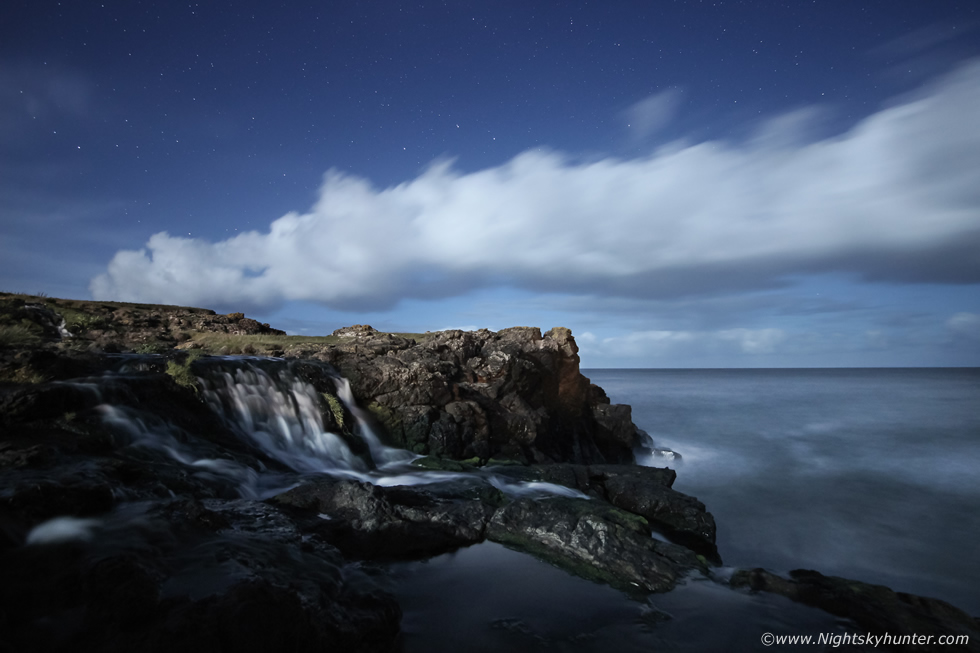 |
John and I met at the coast at 22.00 UT, made an assessment of the sky then relocated to the beautiful waterfall at Dunservick harbour. We hiked through a trail, over a fence, then across a beautiful moonlit landscape of meandering grassy hills with rock outcrops jutting out from the sea which rumbled nearby. We got set-up at the waterfall and took in the view, the night was wonderful, I already sensed this was going to be a memorable shoot and I was already getting the nature fix I had been craving. Due to the low angle of the ecliptic the moon was low in the sky, we reckoned we had less than three hours before it set behind the hills so we decided to make good use of the low contrasty light we had. We got our cameras set-up on a mound of rock with water flowing all around us, shot stills, then a time lapse for over an hour. This is one of the stills, I was shooting with the 10mm F/2.8 Samyang with aperture stopped down one click for improved sharpness, ISO1600 and an exposure of 25 seconds using tungsten white balance. You can see how low the moon light angle was, the foreground to the left was in shadow while the moon light caught only the higher rocks. This location really is incredible at night, we stood here chatting then in silence for a period with each of lost in our own thoughts, all we could hear was the rhythmic sound of flowing water which felt extremely peaceful, I felt in heaven.
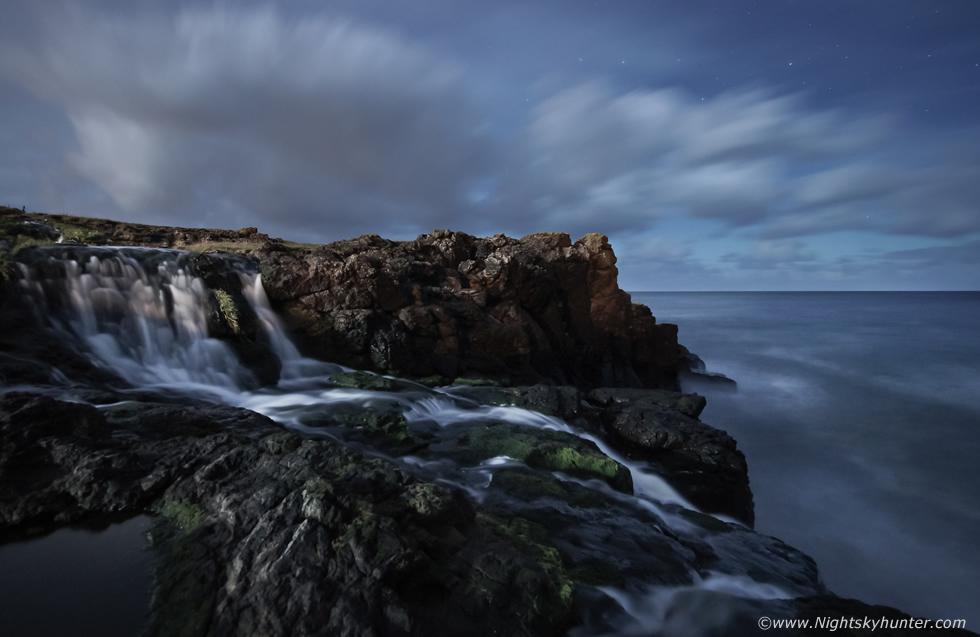 |
Over an hour later we changed compositions for our second time lapse of the night. I moved closer to the edge so I could get in more of the sea and get the foreground structure closer to the camera. For this scene two of the tripod legs where actually in the flowing water. John was to my half right shooting just outside my frame, we absorbed the tranquility and while waiting for my time lapse to finish I undertook a naked eye dome search. This is when I scan the entire visible sky with the naked eye, in essence to see if the sky is behaving itself. I check the constellations which are present and re-familiarize myself with star positions and magnitudes just in case a Nova or Supernova has suddenly erupted, I also check a few naked eye variable star positions such as Delta Cephei, Algol the 'Demon Star', RCrB and the vacant space where the old Nova TCrb resides just in case it came back, then once content all is well I enjoy the sky and landscape around me. There really is nothing better than the sound of a camera's shutter clicking when shooting a time lapse under the stars.
Despite the serenity it was also quite dangerous standing here, you see the rock edge to the lower right?, that's where the waterfall dropped over the edge of a cliff into the sea, that's very close to where we stood. Furthermore the rocks were wet and slippery, my boots were constantly sliding on the wet rock, had we slid off into the flowing water we could have went over the edge into the sea, I tried to put this thought to the back of my mind. As long as I stayed aware and was careful with my movements I would be fine, it was all about patience and slow deliberate motion and situational awareness. The sea itself was frightening at times, no big waves, but rather the sea would rise and fall a great height near the lip of the waterfall, it was astonishing how rapidly it sank far below then surged upwards to near the rocks with such power. On the horizon you can see an enhancement to the sky which was a weak aurora display.
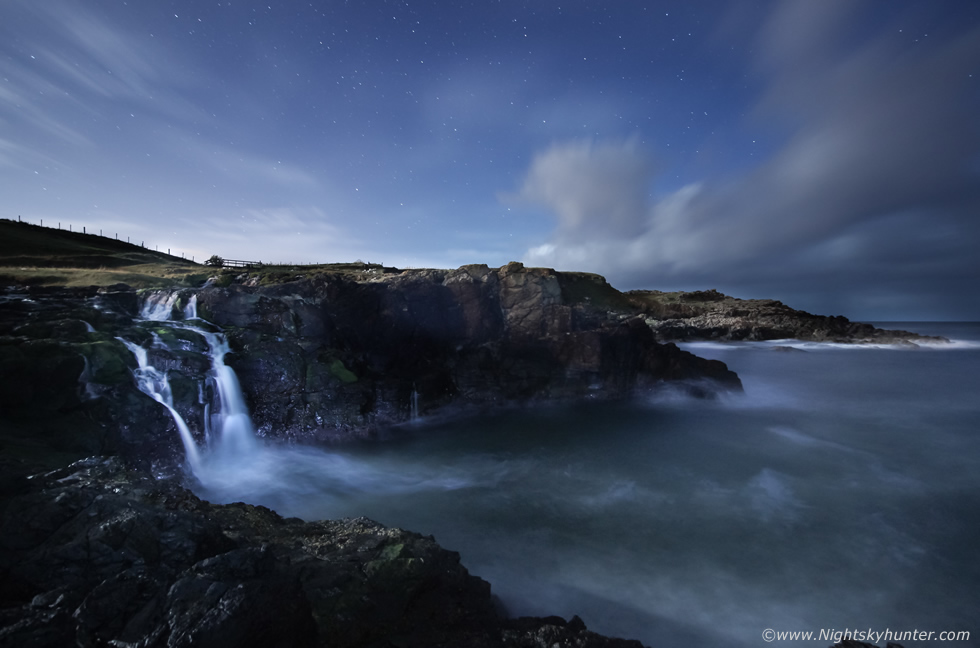 |
The chill was getting to us, especially when standing still for so long so we went back the vans, had a warm brew and snacks then returned for our third time lapse of the night. We ventured around to the E side of the waterfall, here we faced W to SW. I experimented with a much longer exposure, I stopped the lens down to F/4.5, ISO800 and did a 45-50 second exposure, I also gave the waterfall a quick blast with my head torch to make it stand out more. During the course of our time lapses we witnessed our finest moonbow of the year, a stunning sight with complete primary and secondary bows, very bright, and with blue, yellow and red colours to the naked eye, however they formed out of frame to our right, had that spectacle formed over the waterfall we would have had a stunning scene, however as it was the waterfall itself in the moonlight with stars was beautiful. The cloud increased so we called it a night, I made it home for 03.30 UT, a good productive night out in nature.
October 26th
Our first Arctic air mass of the season and a rare chance of capturing moonlit convection. Cold unstable air with 100 CAPE over spreading warm SSTs with -40c air aloft would generate convection with a risk of hail showers and even brief wintry flurries on high ground inland. With an astonishing 100 knots of deep later shear cells would be organized with a slight chance of thunder. What made this shoot decidedly iffy was the wind, the Met Office were going for 20-35mph bitter winds blasting the north coast and combined with convective downdraughts and outflow we could get briefly severe squalls. We knew this was going to be a bitterly cold shoot but we wondered, would we get shooting at all?, such winds could ruin exposures and shake cameras but we decided to go anyway, our plan was to visit Ballintoy Harbour and use the land there to get shelter, our exposure to the cold would be short, the idea was to get shots then return to the shelter of the vehicles, in and out to get what we needed and back again. It turned into a group shoot with four of us in action. Paul Martin arrived from Omagh then he and I made our way to Ballintoy where we met Nigel McFarland and John Fagan, then we were immediately out in action.
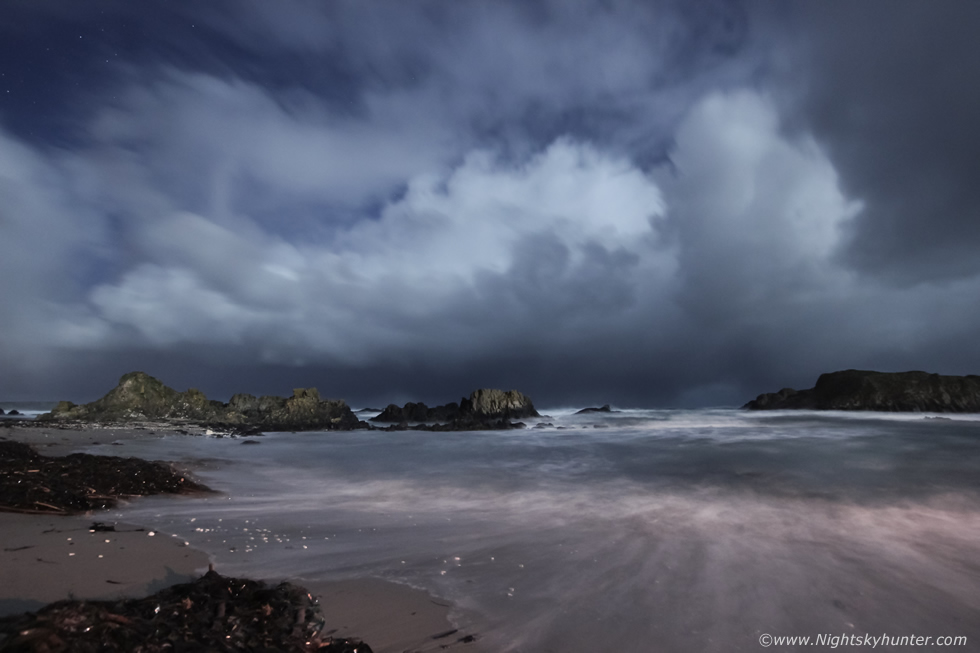 |
We made our way to the W of the car park and started taking exposures of moonlit convective cells, this one made for a nice scene behind the stacks with a core of hail falling over the ocean. It was moving rapidly from R to L on the strong Nly flow, our tripods shook in the wind gusts so I had to grab the mount head and legs and hold them steady until the exposure was complete, this wasn't as straight forward in practice though. A big squally shower came on shore to blast us so we took shelter in a cave until it passed, I was filming a vlog this night so I was trying to capture the essence of the shoot for a future video.
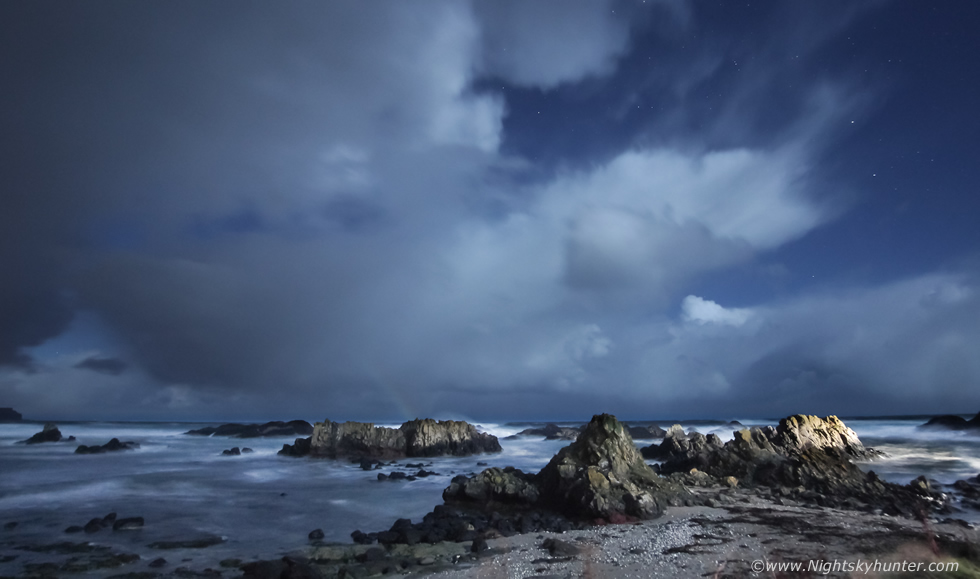 |
When the rain passed we all emerged from the cave once more to capture yet more cells catching the moonlight where a partial moonbow manifested for several minutes. The rocks were lit up due to a car in the car park, the owner of which wouldn't turn off their headlights, its beyond me why people do that, I've seen people shinning their headlights across the sea looking for the aurora and that's not a joke.
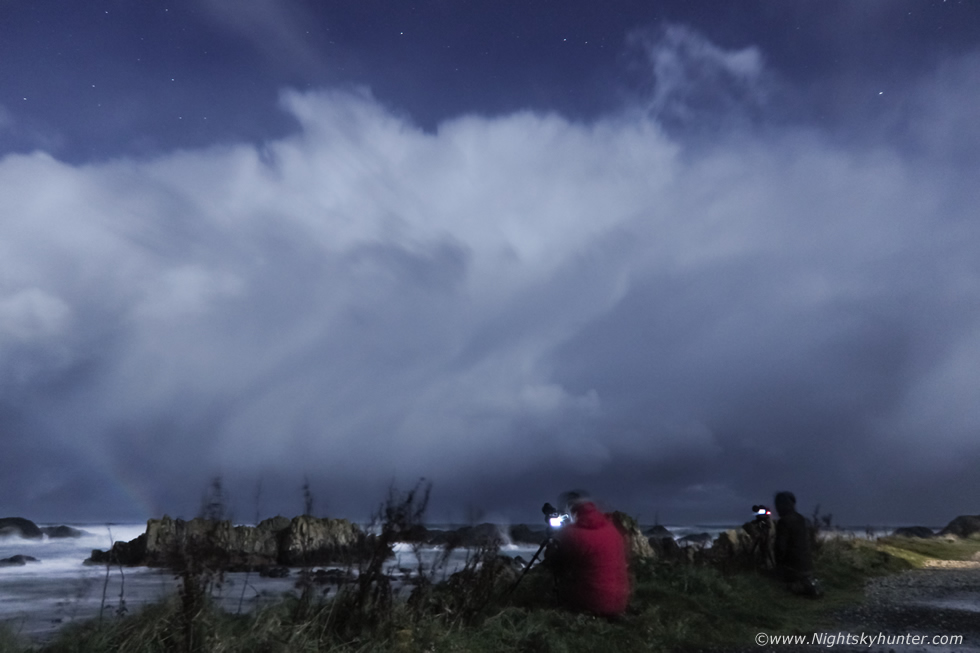 |
Nice big cell flirting close to shore with rain and hail falling in swathes over the churning sea, moving R to L. I switched to the 18mm kit lens for this one and captured the guys shooting the scene just as another moonbow appeared. The outflow wind from the cell lashed the shore whipping my tripod causing it to shake, I had to grab it to stop it blowing over until this exposure was complete which is why the foreground looks soft due to motion blur. I really like this scene, it captures the essence of the moment, the thrill of the hunt, man versus nature, they didn't know I was taking the image so it captures a genuine moment in time, that's Nigel on the left and Paul to the right.
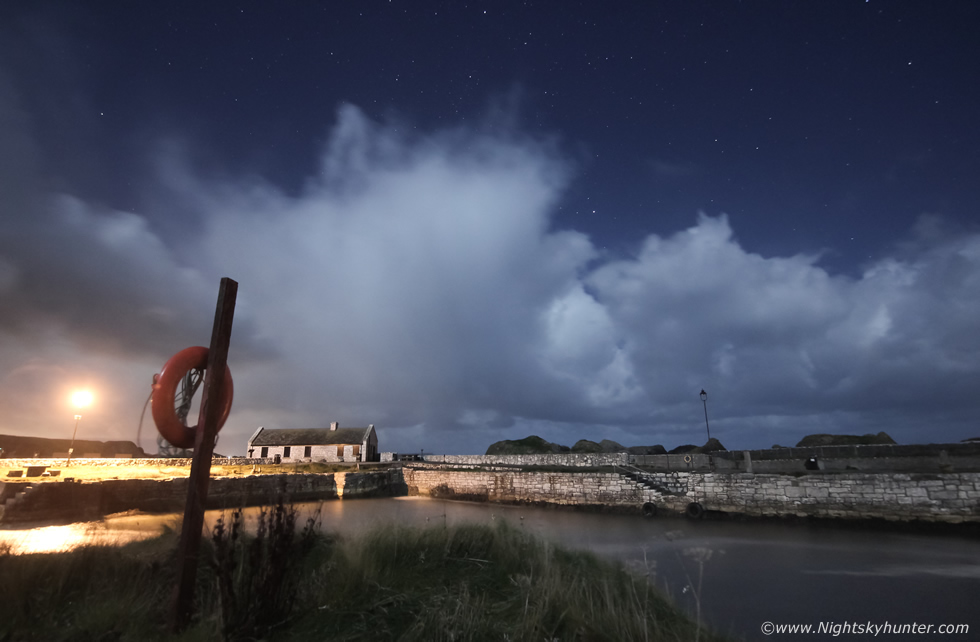 |
The bitter wind began to chill us so later we took shelter in a large cave where Nigel surprised us with a BBQ. In the relative warmth of the cave we devoured burgers and a hot brew which was warmed us up for round two, thanks Nigel for this much needed energy boost. We checked out the area around the harbour itself where thankfully we found shelter. This is looking across the harbour inlet past the life buoy to Roark's kitchen cottage, beyond can be seen moonlit showers with Cygnus, Lyra and Draco aloft.
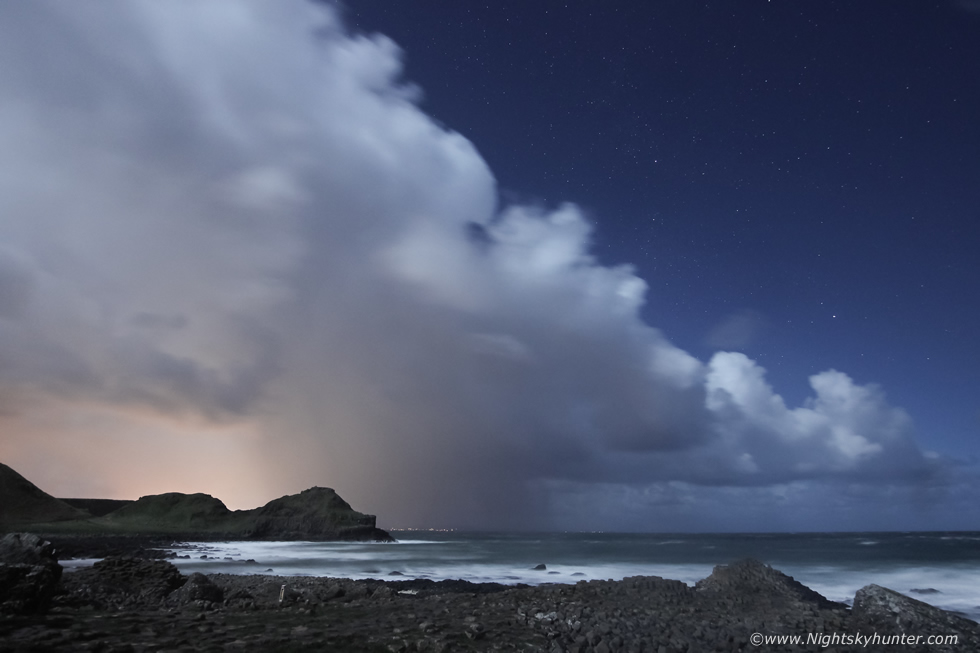 |
Later in the night we went to the Giant's Causeway and it was here we saw the best cell of the night. Check out the lean or shear on this updraught!, the tower is leaning over far to the left, in fact the actual updraught top/anvil interface stretched from the sea rite over inland coastal areas, we had just got a report that Coleraine was white as snow from hail stones, this one was no doubt doing the very same rite now. Cell moving R to L, core below, updraught at 45 degree angle and flanking tower with stars, this was the convective scene of the night for me. Had we shear like his during the Summer with 1000 CAPE or more we would be experiencing a supercell thunderstorm.
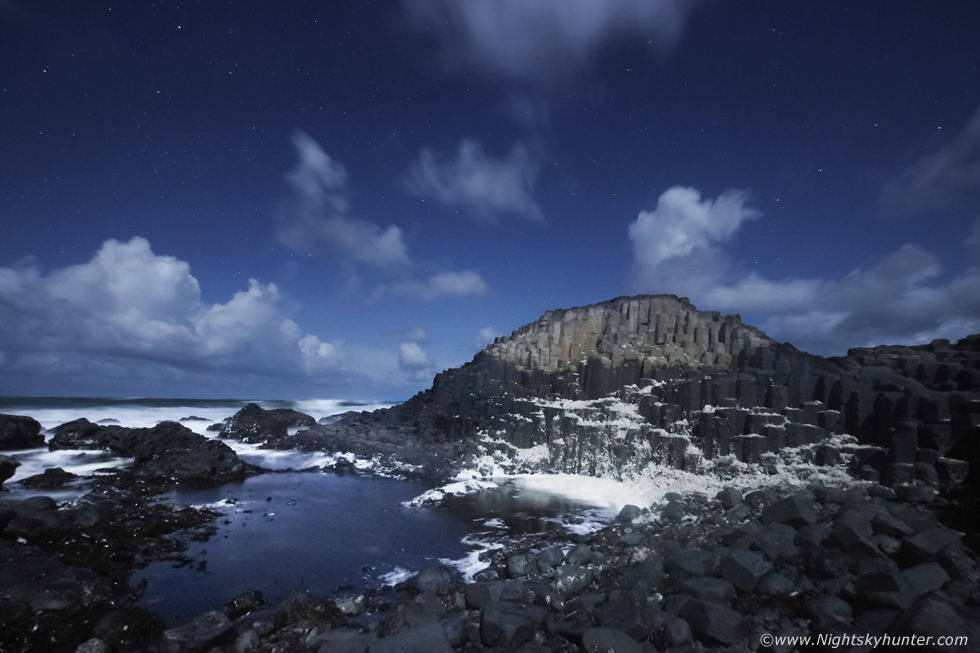 |
All four us went our own directions for a solo shoot. I ventured down to the famous Causeway 'pyramid', I was delighted to see that the west side of the rocks was covered in sea foam from the recent stormy conditions, it looked like snow in the moonlight, I had never captured this before at night so I settled in for a shoot and ended up really getting in the zone. I was sheltered and rather comfortable, the tide was out so I was safe. This was 10mm with aperture stopped down at ISO800 and long exposure in the 45 second range, the moon popped in and out from scudding cloud making the rocks bright then dark which added to the moody atmosphere.
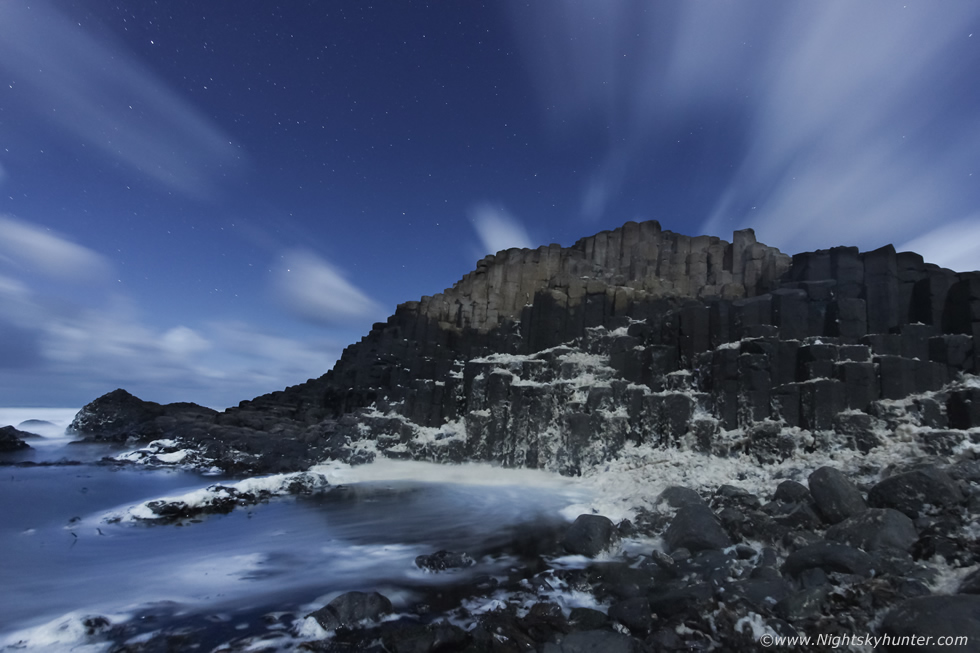 |
Using the 10mm again only this time I carefully made my way closer to full more of the frame with these famous 50 million year old basalt rock formations. The moonlit foam looked very cool, on occasion a large lump of foam would blow past my face and camera, I was loving this moment, the exposure was 50 seconds which made the clouds streak more accentuating the long shutter look, I also liked the swirling motion of the sea below. For me this was my trophy shot of the night, I was well pleased with it. After another brew we called it a night and made it home for 04.00 UT.
November 9th
This mid week photo shoot was arranged at the last minute. The Met Office forecast was going for clear skies all night long which would be the best night of the week, there was also a chance of Taurid fireballs and there were several faint comets I wanted to observe so a night at the coast with its fabulous dark skies would be the perfect location for photography and observing. I packed a flask, snacks, then placed my Meade 8" LX10 F/6.3 S.Cass telescope in the van with a 20mm SWA eyepiece, I hoped to squeeze a bit of everything in this night, if I could get a decent image and visually observe these comets I would consider the night a success. The sky would be dark and moonless which would suit all my needs. Photographer Nigel McFarland from Limavady decided to join me too so it looked like a good night ahead, we decided on Ballintoy harbour. An active frontal system had been producing significant rain over all of N. Ireland during the day and evening but was expected to clear by nightfall and sat images confirmed a sharp clearance in its wake so it looked to be game on.
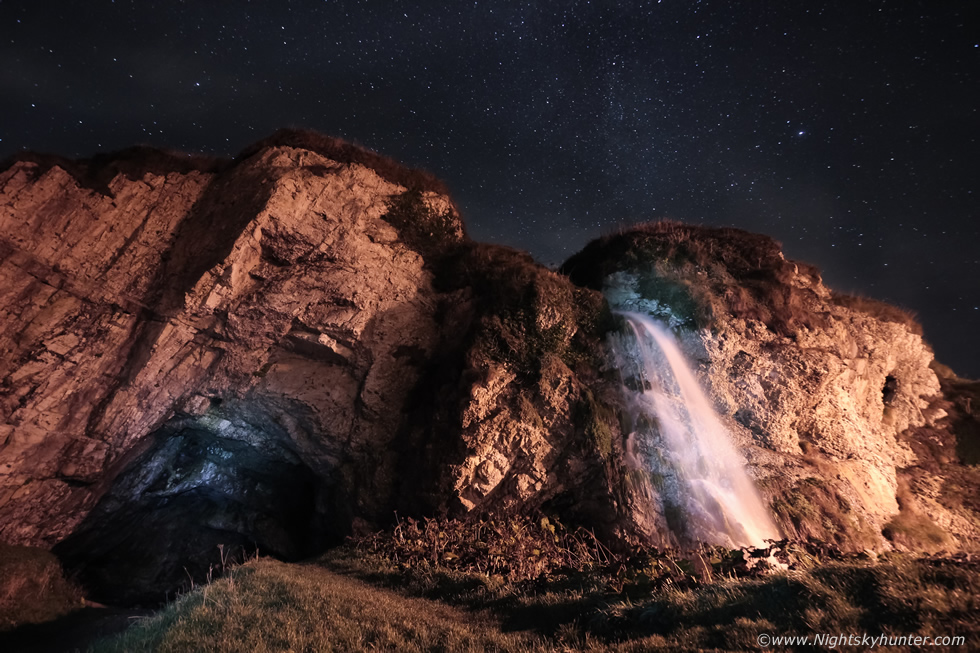 |
We arrived at Ballintoy car park, with the exception of one car which soon left, the place was devoid of people and other photographers which was great so we had the place to ourselves. We were prepping our gear with the intention of hiking around to the W side near White Park Bay where the stacks were located however the car park area immediately got our attention. A striking waterfall was flowing down the cliff near the cave, we were taken back, I have came here many times over the years for a night shoot and never before had I seen a waterfall, our plan changed, this now became the focus of much interest, if we could get an exposure of this with stars it would make for an attractive and usual scene. The exposure worked out, however the lights out of frame to the right were producing orange lens flares on the image, so we had to take exposures, then slowly move the tripod closer to the cave until we found the sweet spot where no flares appeared.
The sodium glow illuminated the rock face for us nicely and the exposure captured the stars aloft, you can see the glow of the Milky Way running vertically through Cygnus and Lyra. We used our torches to light up the waterfall which lifted the scene even more, then Nigel walked into the cave and briefly lit it up from within which provided a sense of depth in the cave. The combination of warm sodium light and cooler torch light made for a dramatic result, this image alone had already made my night, in fact, it might even be my personal favorite night image from this year to date. At this point I was already satisfied so anything else captured would be a bonus.
 |
We then ventured inside the ancient cave. Due to the incessant rainfall water was dripping like mad from multiple sources from the cave ceiling so we backed up to the far end where we found an area free from droplets. This was a tricky one, every image I took the harbour light fixture and buildings appeared in the image, so I had to lower the camera close to the ground with tripod legs fully collapsed and spread wide, this way the cave entrance was free from obstructions which made for a more effective composition. 10mm wide angle, ISO1600, aperture stopped down two clicks, a very long exposure ensued, possibly 60 seconds if I recall from memory. Nigel gave the inside of the cave a quick sweep of light and the sodium glow from outside illuminated the entrance, I was well pleased with this result. You can see the circumpolar stars through the cave and if you look carefully to the right of centre you can see the water dropping in streaks from the ceiling. When we emerged outside the waterfall had vanished, it was literally gone, we were delighted we got our images just in time.
We then had a brew and roasted marshmallows over a flame then made our way around to the west side as originally planned. We shot two full time lapse/star trail sequences and observed the sky, during which time we observed 14 Taurid meteors and 2 sporadics, at one stage I witnessed 2 Taurids one behind the other burning up in the SW. We made our way back to the harbour and set up the 8" and observed several deep sky objects then hunted down short period comet 64P/Swift-Gehrels in Andromeda at mag +10.0, DC3, Dia +5' as a large elliptical fuzzy haze with condensation at centre within Andromeda not far from the naked eye star Mirach or Beta Andromedae. Then after some effort due to eyepiece issues I found 38P/Stephan-Oterma in Gemini in a field rich with stars which subdued the comet's glow due to the proximity of a bright field star. The comet was close by to the W of the Eskimo Nebula at mag +10.5, DC3, Dia 4', a soft diffuse misty blob with condensation at centre, that's two comets observed and my night's list of targets all accomplished.
The interesting thing was that as Nigel observed these ghostly hazes in the eyepiece I explained that's what a new comet would look like at discovery, and imagine the skill and knowledge required to discover something like that except it being lower in the sky close to the horizon in twilight. The next day we learned about a new and extremely rare visual amateur comet discovery in the morning sky within Virgo at mag +10.2 (the same brightness as these comets) designated C/2018 V1 Machholz-Fujikawa-Iwamoto, talk about amazing synchronicity!!!, I would later observe the new comet pre-dawn on Nov 12th five days after discovery.
November 13th
I was eager to observe new comet C/2018 V1 Machholz-Fujikawa-Iwamoto which had just been discovered by amateur comet hunters five days earlier in the morning sky. After a period of cloudy weather the pre-dawn hours of November 3rd were forecast to be clear so I planned on 'meeting' this new comet then. I went to sleep then my alarm woke me at 04.00 UT to a wonderful clear dark sky, in fact, the best clear sky I have seen for some time. I changed and headed out to the back garden and it was then I realized I would never catch the comet from here due to it's low altitude so I packed my Meade 8" F/6.3 LX10 into my van then drove into the Maghera countryside to find a dark location which offered a good low view to the E. I tried several locations however trees blocked my view then suddenly an ideal vista came into view, I ended up reversing into a narrow grass lane between fields with hedges on both sides which hid me from view, the visual profile to the E was perfect.
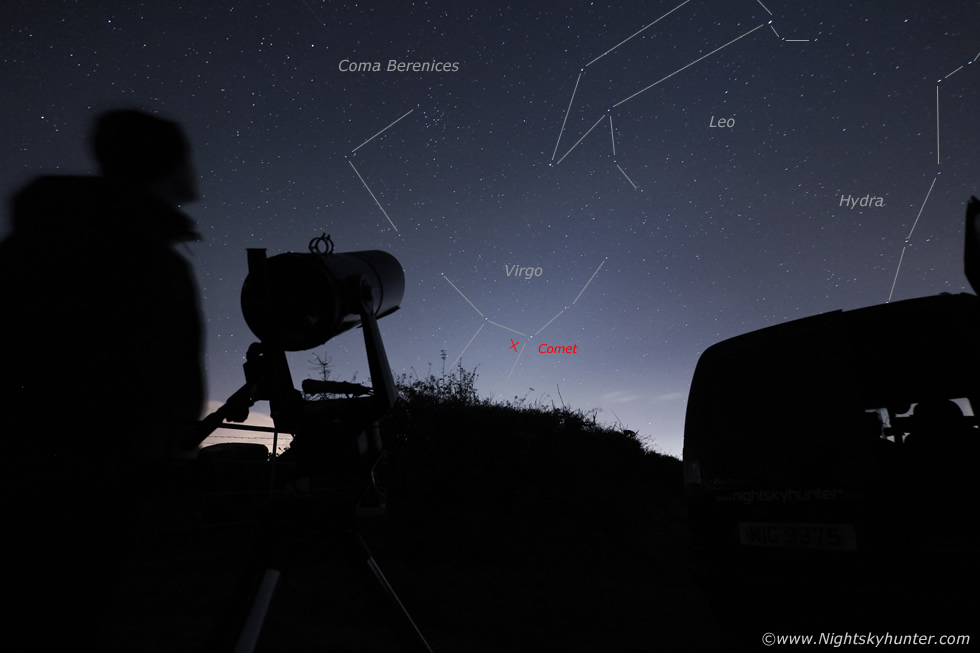 |
I set up the scope and began sweeping however the low altitude was rendering stars faint and the seeing made stars within the FOV turn to blobs. The sky clouded over and began to rain so I waited and waited, then finally the shower stopped and the stars re-appeared better than ever before. The pre-dawn sky really was a place of celestial glory, Orion and Sirius sparkled like vivid diamonds akin to a scene from a Christmas card. I settled myself and observed M81, M82, M35, M31, M32, M1 and M42 then when fully dark adapted I turned the mount to the E and began a slow horizontal sweep through Virgo and a few minutes later I found the comet at 05.00 UT some 10 degrees above the true horizon and 1 degree above a strip of cloud. I was thrilled and overjoyed to finally get to see this fresh discovery, I was genuinely on a high. The comet was located to the E of naked eye Porrima and in the telescopic field it was a striking sight, my first impressions were that this comet was bright and very well formed indeed. At a casual glance it looked like an unresolved globular cluster, the coma was a well defined round form with relatively sharp edges, at centre was a white disk-like central condensation with star-like false nucleus within. On two occasions during moments of good seeing I glimpsed an elongation to the W which must have been the tail recently captured on CCD images.
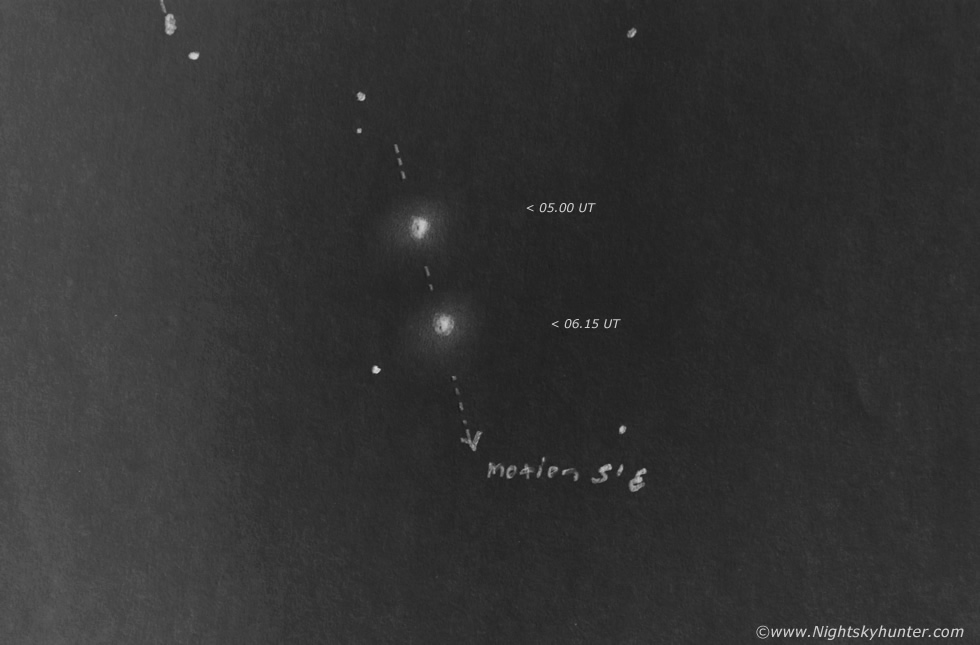 |
I was astonished how rapidly the comet moved so I made a sketch and returned periodically to the eyepiece only to see that the comet had clearly moved. The above sketch shows this motion between 05.00 UT and 06.15 UT, during which time it moved 5'. I made a rough magnitude estimate at +8.6 however I really suspected it was brighter than this. Once the comet climbed higher within the growing twilight a sublime aqua hue could be discerned from the coma which was my final view of the comet before advancing twilight and the singing of birds ended the session. I wonder what this comet has in store?, we will find out in the next few weeks. I would like to congratulate all three discoverers for this exciting surprise comet. When planet Venus rose above the country hedges it made for a stunning sight, for a few seconds I thought it was an approaching aircraft with bright lights, it looked all the more surreal located close to the Spica. I made it back home for 06.30 UT buzzing with contentment.
November 21st
Sometimes the unplanned sessions can be the most fun and productive, especially so when it happens mid-week. This was was nothing but rain and cloud non-stop for hours this day, a cold spell was also moving in from the E and satellite images indicated that clear air would advect inland from that direction during the late evening and early night accompanied by a small amount of CAPE. The moon would be almost one day from full phase so it looked like a great chance for another moonlit shoot at the north coast. Nigel McFarland and I decided to make the most of it and after some rushed communication we prepped our gear and got ready, I made sure to layer up and wore thermal gear as it looked to be a very cold night ahead with possible frost later. When I left Maghera I drove through heavy drizzle under thick cloud as far as the eye could see, I was having my doubts about clear skies but decided to take a gamble and trust my instincts, I also had faith in the satellite images. At one stage I contemplated turning around and going back home as the sky looked absolutely dire but something made me drive one, once I arrived at Coleraine large clear sectors moved in from the E as predicted and the moon appeared shining with pride, I said ''yes!!'' out loud and pressed on.
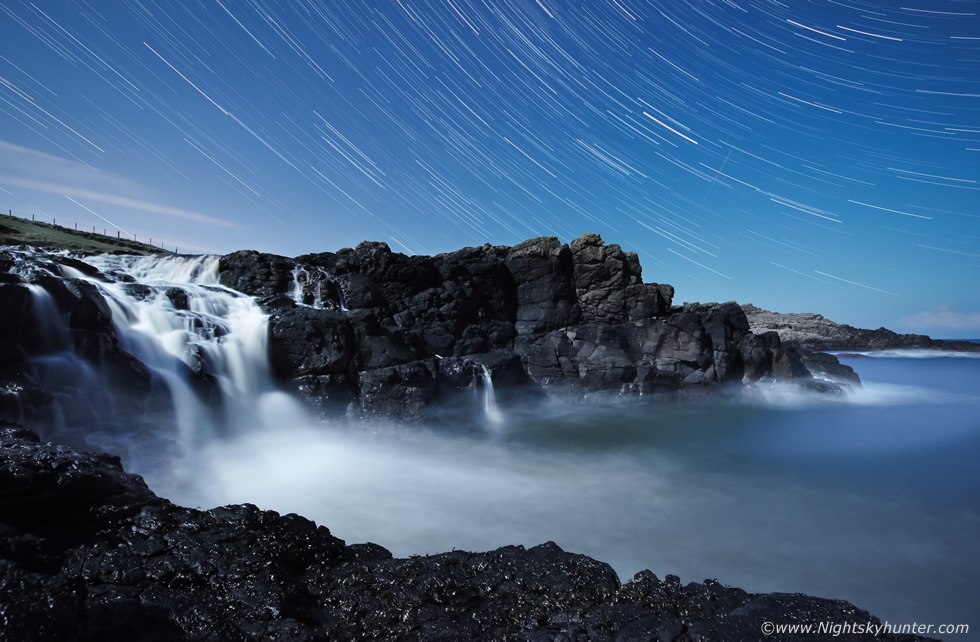 |
When I arrived Nigel was already waiting, we both marveled at the stunning clear sky, our concerns vanished as we took in the view which was clear from horizon to horizon, with the exception of scattered cumulus drifting past the night was beyond our hopes. We trekked over the rocks to Dunservick waterfall which we had been eager to re-visit once again. There's something about this place on a moonlit night, it draws you in, perhaps its the visual beauty or majesty or the sound of flowing water which makes you feel at peace, I also wanted to try a few new angles and acquire time lapse material for my end of year video presentation. We climbed over rocks, spent a good half hour shooting stills from various angles as we adjusted to the location then we settled in for a time lapse. This was 10mm wide angle with the Samyang 10mm F/2.8 lens stopped down one click at ISO1600 shooting at tungsten white balance. The light in theses images is all moonlight combined with long exposures and stacking, my shutter was 20 seconds, this is a star trail from a selection of the images obtained.
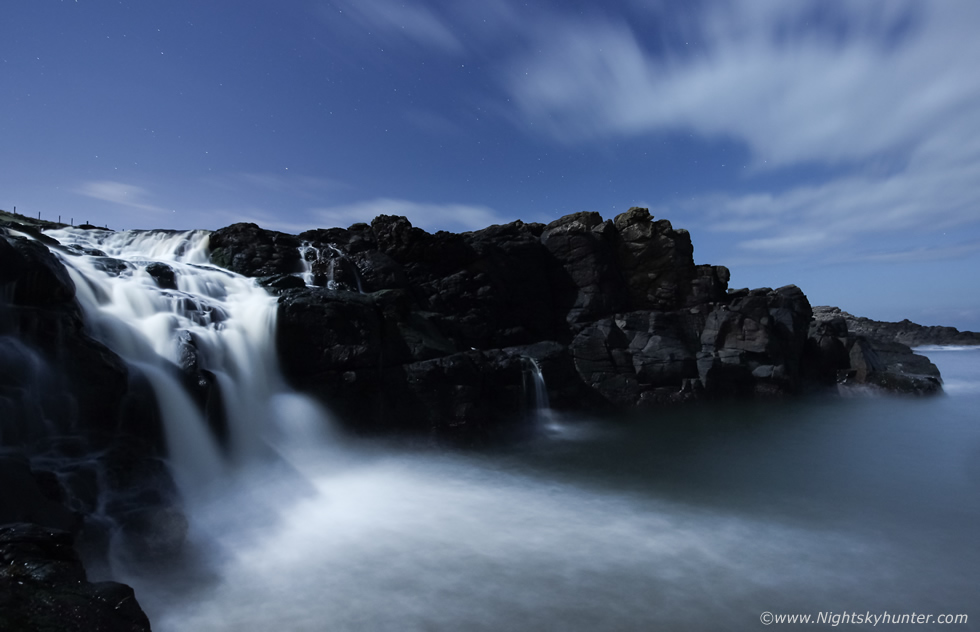 |
Later we were back to shooting still exposures, I very carefully lowered myself down the slippery rocks close to the sea which was a risky proposition. Luckily the tide was going out and I had monitored the behavior of the sea state for some time to note any swell patterns which could take me by surprise. I moved a few inches at a time, very slowly, every boot placed with purpose, then got as close as I dared. This is one of the exposures, the sea rose and fell which was hypnotic to watch. Crouched here up close and personal to the sea and waterfall was both intimidating and exhilarating at the same time, I used my phone to record the sound of the waterfall to capture the memory.
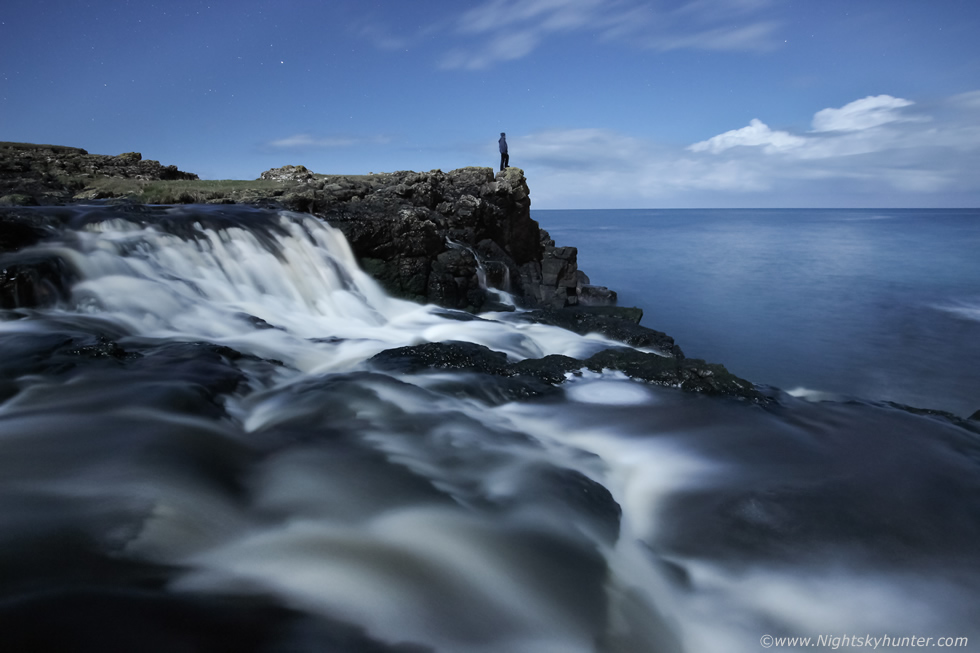 |
One hour later we made our way back up the rocks to the uppermost part of the waterfall, I jumped over several rock outcrops and landed on the centre of a small rock surrounded by flowing water. I lowered the tripod and shot this wide angle scene with beautiful pattern in the water flowing over the rocks. I began shooting a time lapse then made my way around to the other side and stood on the highest rock for a rare selfie.
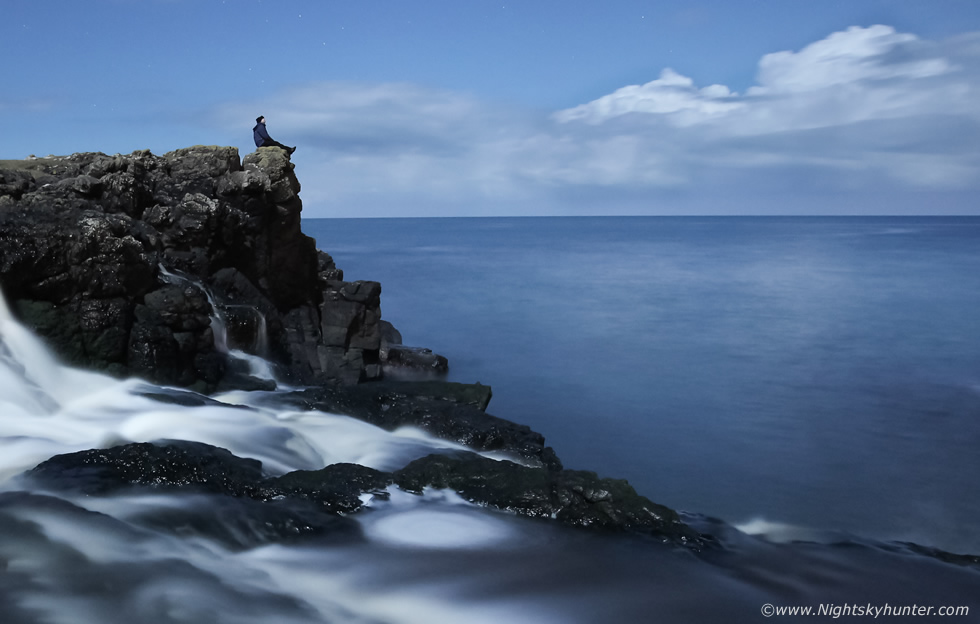 |
Crop from another exposure for the memory. You can't appreciate it here however the view was amazing from where I sat, I was on the highest point in that area and below me was a massive drop down the side of a cliff to the ocean below where our waterfall could be seen flowing into the sea, the world around us was bathed in moonlight, it was such a wonderful moment.
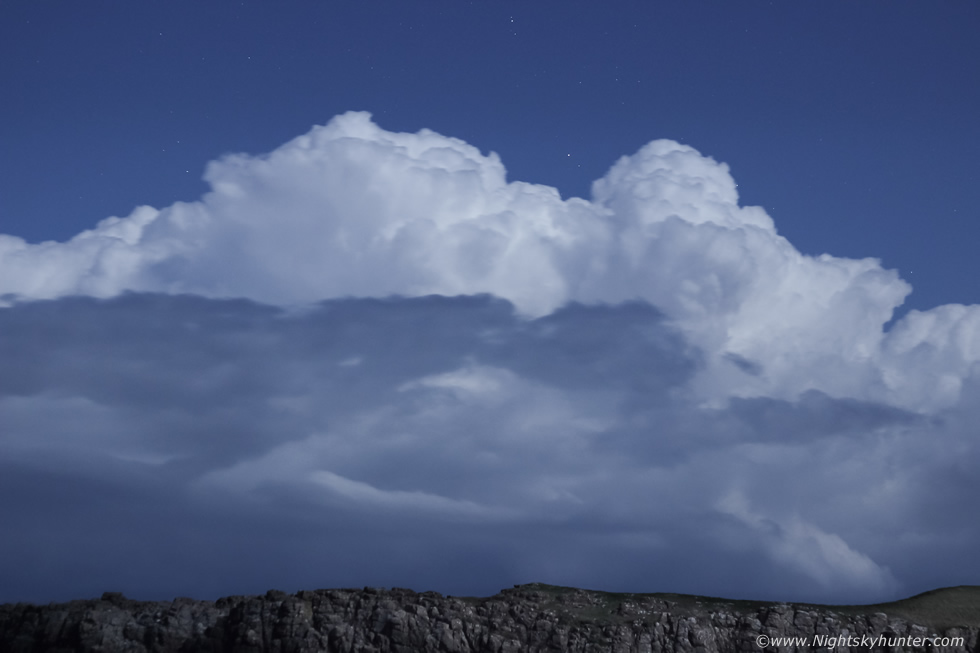 |
Over an hour later I ended my time lapse as something was happening. A huge line of convection had formed covering tens of miles, it had initiated over the Irish Sea and North Channel where it bubbled up in the unstable air over the warmer water, the Ely flow began to push it inland somewhat and as it did so we had a perfect view of the entire process. I switched to the 50mm F/1.8 lens to capture this cell which was bubbling up very nicely among the stars, moving R to L in this image. Nigel and I then shot a new time lapse, I actually shot two sequences, one at 50mm and the other at 18mm which turned out very nice.
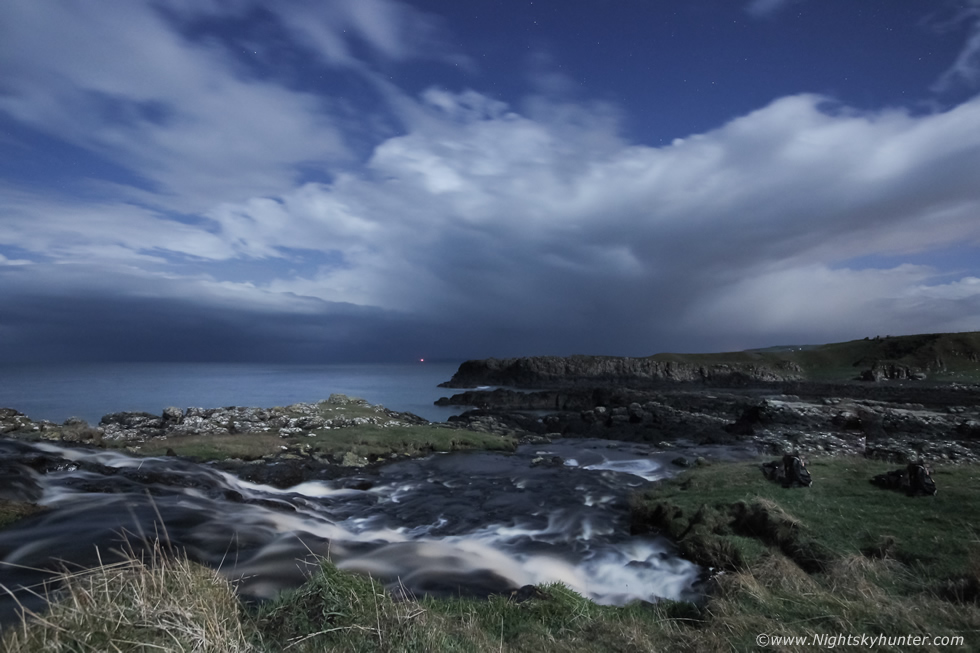 |
A large cell formed and developed what appeared to be a low-topped anvil, it became so large we had to revert back to the 10mm wide angle lenses. It was this scene which made the entire night for me, big unexpected cell over the sea moving R to L over a coastal landscape with moonlit waterfall. This line of convection was dropping hailstones over E inland areas and even a dusting of snow on the peaks of the Mourne mountains.
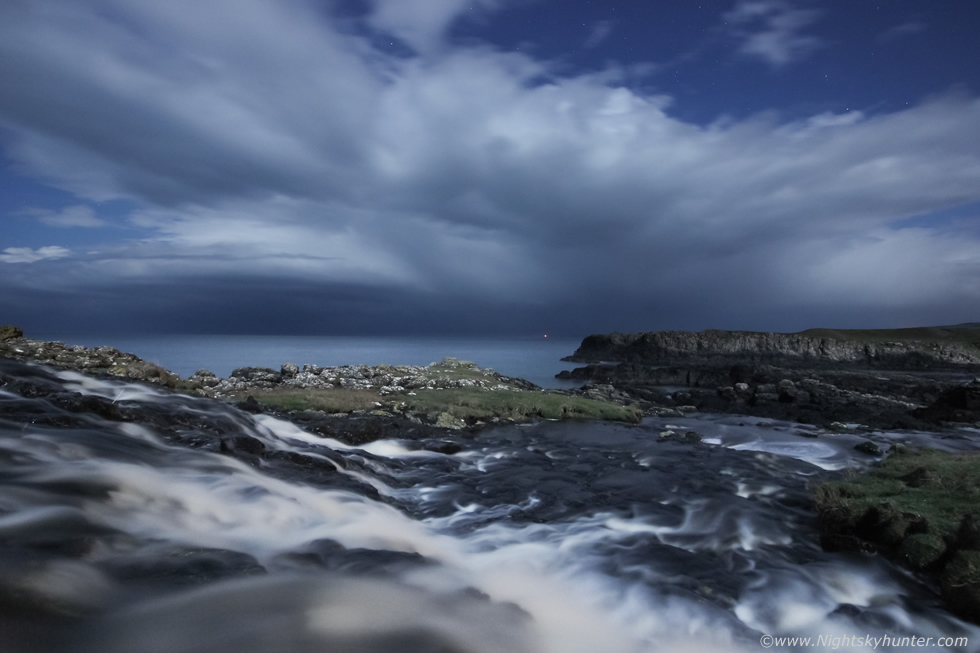 |
Looking along the waterfall as it flowed over the edge into the sea below. As the cell transitioned from the unstable North Channel to the cooler and more stable North Sea it began to weaken and as it did so it formed this interesting laminar outflow feature along the gust front region which made for a very photogenic moment.
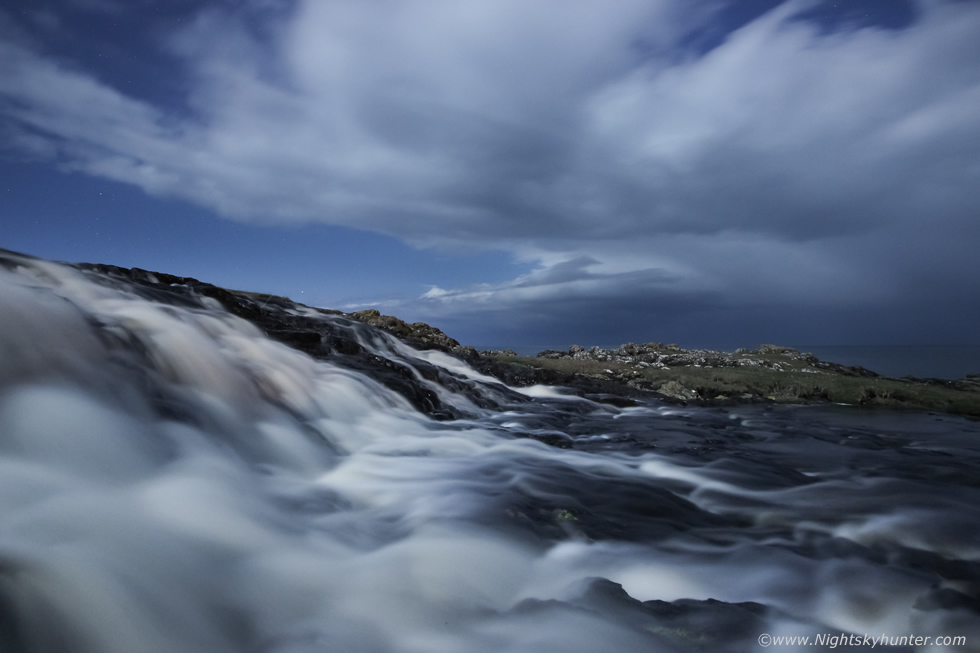 |
Last exposure of the night as the cell collapsed over the cold North Sea with our beautiful waterfall in the foreground. The time was 02.00 UT, I had a brew then Nigel and I began our drive home. The temperature was -1C for the entire drive from Coleraine to Maghera then it clouded over at 03.00 UT, our timing had been perfect.
A vlog filmed on October 26th 2018 at Ballintoy harbor and Giant's Causeway along the Co. Antrim coast. Four of us met up for a shoot in harsh conditions with nasty on-shore Arctic winds blasting the shore with regular showers of rain and hailstones. We had a BBQ in a cave then shot exposures at both locations. I included a number of images taken combined with footage filmed at home before the shoot.
Time-lapse sequences captured at the Antrim coast on November 21st 2018. DSLR, 10mm lens, continuous shooting and rendered in lightroom. Waterfall with stars under a moon one day from full phase then convection. Thanks very much for watching for reading.
Martin McKenna